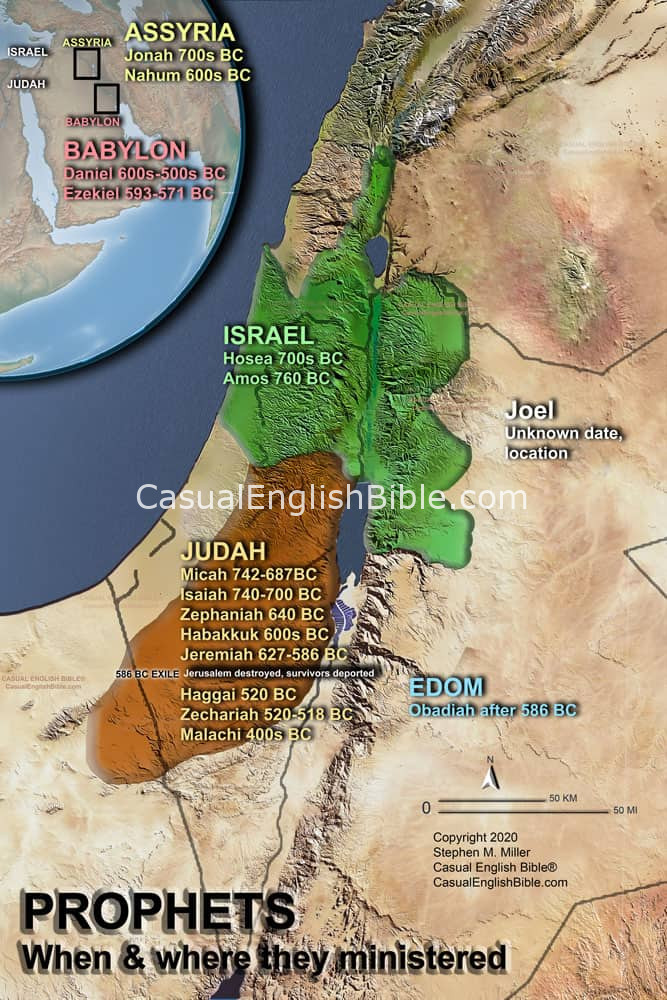Isaiah is the headliner of Bible prophets—his book of prophecy comes first. Yet he didn’t seem to save many souls.
Vision
Isaiah began his ministry after experiencing a dramatic vision or a vivid dream. He saw God in heaven, surrounded by celestial beings with wings.
God asked for a volunteer to deliver his messages to the people.
Isaiah said, “Send me. I’ll go” (Isaiah 6:8).
He was one of the first prophets to preach doom. He delivered that message to both Israelite nations—Israel and Judah. They were thriving at the time, enjoying peace and prosperity. But he said they were doomed mainly because they worshiped idols instead of God.
It seems leaders of prosperous nations tend to ignore messages like that.
With the near-zero effect Isaiah had, he might as well have written “You are Doomed” on a strip of leather, nailed it to a fencepost, and then carried it naked through the streets of Jerusalem. People ignored him.
His ministry spanned four kings (1:1), but the kings seemed to rarely take his advice.
He once warned godly King Hezekiah not to make an alliance with the Egyptians or take a stand against the strengthening Assyrian Empire (Isaiah 28:15). But Hezekiah did both. Assyria invaded, pushed back the Egyptians coming to the rescue, and then destroyed many cities of Judah.
Bad news first
Isaiah delivered bad news to just about every nation in the Middle East.
He said Israelite nations were going to suffer the consequences Moses warned about for breach of contract with God. For turning their back on God, they’d lose their country and get deported (Deuteronomy 28:36).
Isaiah said that in time, God would punish each nation or empire that mistreated his people.
Good news last
It’s not all doom. Just mostly.
In the end of the book, Isaiah offered hope to Jewish descendants of those who had watched Assyrian and Babylonian invaders wipe the two Israelite nations off the map. God promised to bring home his people scattered all over the known world.
Isaiah paints a picture of heaven on earth:
“Crying time is over” and “wolves and lambs will eat together” (65:19, 25) instead of eating each other.
Some Bible students say that’s a metaphor for peace. Others say they take that literally, and that they’re waiting for Jesus to come and create a world like that. Some Jews say they’re looking for the messiah to come and do that; most don’t say Jesus was that messiah, since wolves are still eating lambs.
Isaiah promises that God will make new heavens, a new earth, and a new Jerusalem. Later prophets pick up those hopeful images as a portrait of a patient God who never stops loving human beings:
“I saw a new heaven and earth. The first heaven and earth were gone” (Revelation 21:1.)
Writer
Isaiah, son of Amoz, gets credit for delivering the messages in this collection of prophecies. But most Bible scholars seem to agree that he’s the source of only the first 39 chapters of the 66 in this book.
The first 39 chapters seem set in Isaiah’s day, in the 700s BC. But the rest of the chapters push hundreds of years into the future.
It might seem reasonable for Isaiah to talk about the future, since he’s a prophet with God feeding him visions of insight. But he talks about the future with the kind of specific detail that no other Bible prophet did, including Moses and Jesus. The chapters read like history, written after the fact.
For example, the writer predicted that Persian King Cyrus (reigned 559-530 BC) would free the Jews from captivity and send them home to rebuild Jerusalem’s walls and the foundation of the Temple (Isaiah 44:28).
That’s awfully specific—and about 250 years in the future. In Isaiah’s day, there was no Cyrus, no Persian Empire, no serious threat to Jerusalem, at least early on. Assyrians attacked later in Isaiah’s ministry.
Some scholars say Isaiah wrote the entire book. The oldest copy of Isaiah was found among the Dead Sea Scrolls, copied 2,000 years ago. The scribe who made that copy treated it like one book. No breaks or notes to suggest someone else wrote chapters 40-66.
Most scholars seem to agree there were two or three writers:
- Writer 1 wrote Isaiah 1—39, prophecies set in Isaiah’s day, 700s BC.
- Writer 2 wrote Isaiah 40—55, during the 500s BC, when most Jews were exiled in what is now Iraq.
- Writer 3 wrote Isaiah 56—66, after the deported Jews returned from exile, 400s-500s BC.
Timeline
Isaiah ministered from about 740-700 BC. During his ministry, the northern Jewish nation of Israel fell to Assyrian invaders in 722 BC. That nation never recovered or rebuilt itself. The tribes that made up Israel became known as the Lost Tribes of Israel.
More than a century later, the southern Jewish nation of Judah fell to Babylonian invaders, in 586 BC. Survivors were deported to what is now Iraq but were released 50 years later by Persian King Cyrus. Some returned home to begin rebuilding Jerusalem’s walls and the Temple. Many stayed.
Location
Isaiah lived in Jerusalem, in the southern Jewish nation of Judah. But many of his prophecies targeted nations and kingdoms throughout what is now the Middle East. These locations included what are today Syria,
Jordan, Iraq, Iran, Lebanon, and Egypt, along with many others.
Purpose
“What’s the point?” is a good question. After all, God warned Isaiah that no one would take him seriously. When Isaiah asked how long he should deliver God’s messages, God answered:
“Until their cities lie in ruins
And all the people are gone
And the houses are empty
And the land lies desolate in destruction” (Isaiah 6:11).
One point of the book, clearly, is that God is patient enough to pursue his rebellious people. But there comes a time to crack the whip, forget the carrot, and swing the stick—punishing the people to redirect them back to God.
Though Isaiah predicts the fall and decimation of both Jewish nations, he promises that God will restore the land and bring the scattered refugees and captives home to rebuild Israel.





